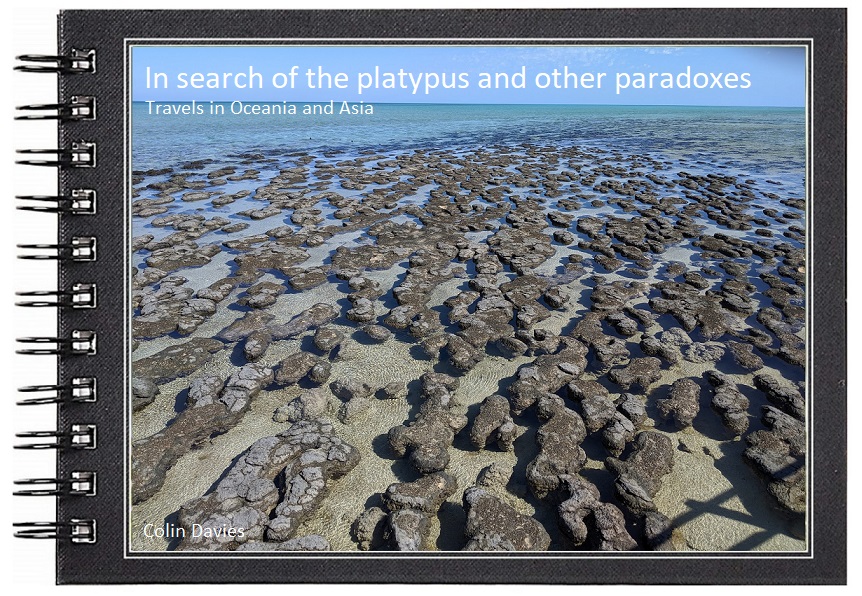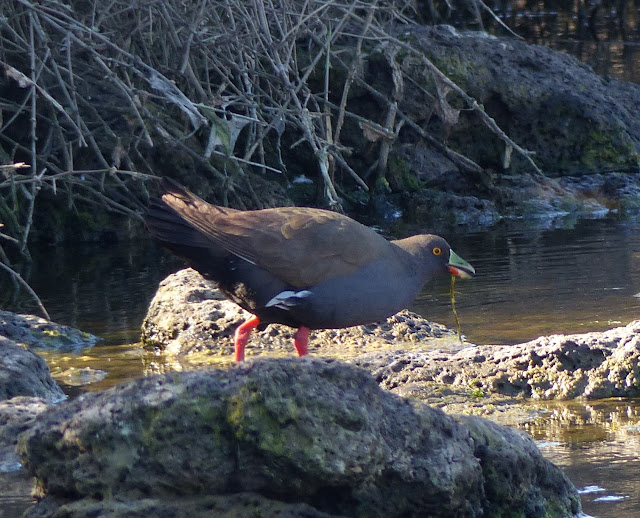Back in Melbourne for a week and the obvious thing to do was to get the key to allow me access to Werribee Western Treatment Plant again. I mean it is rated one of the best wetland sites in Australia so crazy not to go again, and it worked out pretty well actually, the first two weeks I was there I only saw one new species for my Aussie list, yet this week I managed to add several. Key to this success was finally working out where Crake Pond was, and this provided me with not only about four Australian spotted crakes and three Baillon's crakes, but also a pectoral sandpiper and nearby an Australian hobby. In the final analysis, Werribee WTP provided me with 103 species during my stay in Melbourne.
The crakes were wonderful, it was not unusual to see two or three spotted and a couple of Baillon's walking around in the open at the same time. Really smart little birds.
I'd forgotten how small Baillon's crake is. It didn't look much bigger than a starling creeping around at the bottom of the reeds.
Crake pond in the T-Section part of the site.
Australian Swamphens are very common across the site and they're very quarrelsome. This one seemed to be engaging in some kind of threat posture to nearby birds.
Black-tailed native-hens were quite scarce across the site, or perhaps they were just a bit more skulking and difficult to see. The most reliable place that I saw them was at the ford over Little River where I saw up to four birds, but I did also see one swimming across another pond at the other side of the site, so perhaps they were more common than I thought.
It's just amazing the numbers of sharp-tailed sandpipers across the site, they really are everywhere, not only on the freshwater marshes.
As you drive along the tracks they fly up in front of the car or you see them disappearing into the grass as you approach. This goes on for mile after mile, the site is close on 15 miles long.
The treatment plant backs onto the coast and there are thousands of sharpies on the mud flats at low tide.
At high tide they form roosts on many of the pools with mainly red-necked stints, but also curlew sandpipers.
Red-necked stints.
Red-necked stint.
I was delighted to see this pectoral sandpiper on Crake pond. Obviously it's only an Aussie tick for me, but unlike the pec sands we get in the UK which originate from North America, the birds which occur in Australia are from the Siberian population. This is not a common bird in Australia, and the south east is the main place to see them.
It kept itself to itself and all of the times I saw it the bird was on a very short stretch of mud around the back of the pond and away from the majority of sharp-tailed sandpipers. It was not scared of defending it's territory though, and was very aggressive towards any sharp-tailed sandpipers which came too close, often chasing them off.
Curlew sandpipers are quite common at Werribee, though nowhere near as common as red-necked stint or sharp-tailed sandpipers. They were particularly interesting to me because there is a hybrid pairing of curlew sandpiper x pectoral sandpiper known as Cox's sandpiper which occasionally occurs at Werribee, so even though I didn't see one, it was good to get both potential parents! Nothing is as clear cut as it seems though, apparently Cox's sandpiper can only be a hybrid between a male pec sand and a female curlew sand. It cannot be the other way round. Strange......
Pacific golden plovers.
I counted up to 15 marsh sandpipers.
Marsh sandpiper and greenshank.
Marsh sandpiper and glossy ibis. This is by far the rarest ibis in Australia in my experience. I've only ever seen them occasionally, and even then only in single figure counts, whereas Australian white ibis can occur at almost pest proportions in places, walking tamely around outdoor cafes in the center of Sydney for example. Straw-necked ibis can often occur in flocks over several hundred. Of course glossy ibis can occur in big numbers elsewhere, my record was a flock of around 10,000 in Doñana Spain.
The beach stretches for miles and at low tide is full of waders.
This is a smart looking bird, Golden-headed cisticolla, a close relative of zitting cisticolla or fan-tailed warbler.
I saw a few brown hares at Werribee, obviously introductions from Europe.
Horsfield's bronze-cuckoo is about the size of a song thrush. It's a really great looking bird, especially in the right light when it can be quite bronzed iridescence.
Whiskered terns are everywhere, competing with sharp-tailed sandpipers and pink-eared ducks and grey teal for the title of most numerous bird at Werribee. This is part of just one of several roosting flocks, though most birds were in the air.
Here's a short video of a flock feeding over a field. Most of the black birds on the ground are straw-necked ibis.
White-necked heron occurs widely but always sparsely in my experience. I don't think I've ever recorded more than one.
This pale morph little eagle flew over Crake pond. Only my second ever.
It was closely followed by first one, then a second huge white-bellied sea eagle. Both immature birds.
Two white-bellied sea-eagles.
There are thousands of Australian shelducks across the site.
The You Yangs from Werribee.
Small numbers of musk duck occur, 30 was about my biggest count. This is a female I assume because it lacks the large lobe of the male, but perhaps it could be a young male.
I'm not sure if this is some kind of threat posture rather than courtship, I didn't see any other birds in the immediate vicinity.
During my second period at Werribee there seemed to be an influx of freckled ducks. During the first two weeks I had tried but failed to find a single bird, though small numbers were being reported. However in the second period my personal best was about 20 birds.
You may recall this photo from a few days ago which appears to show a brolga on a nest. Well it turns out that it was indeed on a nest, because the next photo shows the result. A brolga chick! These photos taken by Carol Ann Moyse and used here with her permission.
 |
| Brolga chick © Carol Ann Moyse |
 |
| Brolga chick with adult © Carol Ann Moyse |




























































No comments:
Post a Comment